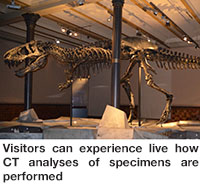Yxlon enters cooperation with the Museum für Naturkunde Berlin
19/10/2018
As part of a newly concluded cooperation agreement, Yxlon is providing the Museum für Naturkunde Berlin (MfN – Museum of Natural History in Berlin) with a high-resolution computed tomography (CT) system, the Yxlon FF35 CT. The system, which required the museum to remove a window of the historical building for its installation, is due to be up and running in the Hall of Microscopes behind the famous Tristan Room. The flood of visitors who come to see Tristan, the first of two original Tyrannosaurus Rex skeletons found in Europe, can then look forward to the next attraction one door further along. From the Visitor’s Gallery, they not only have the opportunity to view original exhibits such as skulls and skeletons of mammals, fossil specimens from different rock layers with inclusions and highly diverse preservation techniques, drilling samples with mineral particles, contrasted reptiles and amphibians and nailed insects, but they can also experience live how CT analyses of these specimens are performed. Museums are increasingly utilising non-destructive CT, not only for scientific research in areas such as evolution, paleontology or paleoecology, but also for the digitalisation of billions of specimens in natural and human history institutes globally, which is growing in significance. One reason for this is that digitalisation can be used to examine valuable research specimens in detail, without having to put them at risk through handling. What is more, the digital objects can be made available to scientists throughout the entire world. This exchange between researchers across the globe not only enables new and innovative research methods but also safeguards preservation and archiving for the future. The Museum für Naturkunde Berlin has been utilising this technology for many years and has gained a deep insight into the opportunities and challenges associated with CT.
Museums are increasingly utilising non-destructive CT, not only for scientific research in areas such as evolution, paleontology or paleoecology, but also for the digitalisation of billions of specimens in natural and human history institutes globally, which is growing in significance. One reason for this is that digitalisation can be used to examine valuable research specimens in detail, without having to put them at risk through handling. What is more, the digital objects can be made available to scientists throughout the entire world. This exchange between researchers across the globe not only enables new and innovative research methods but also safeguards preservation and archiving for the future. The Museum für Naturkunde Berlin has been utilising this technology for many years and has gained a deep insight into the opportunities and challenges associated with CT. High resolution is indispensable for the best reconstruction and visualisation. With its dual tube technology, comprising a 225 kV microfocus tube and a 190 kV nanofocus tube, the FF35 CT system provides the highest resolution with a degree of detail down to 150 nm, in conjunction with the special Yxlon flat detector. The use of helix and dual-helix CT enables even large objects up to 50 cm in height and 30 cm in diameter to be scanned with high resolution. The problem of adequate contrasting is encountered, especially when it comes to the resolution of structures in low-contrast soft tissue such as organs, muscles and fat cells. A central task of the Museum für Naturkunde Berlin will be to find solutions and process optimisations using contrast media, while assisting Yxlon with the corresponding technical refinement of the CT system and its software. The presence of metal artefacts in samples as a result of the nature of their preparation (as, for example, occurring with needled insects) are also some of the challenges that Yxlon and the museum will tackle in their cooperation, with the joint goal of specially optimising CT for the field of life sciences, while ensuring they are ideally prepared for the requirements of digital archiving of biological specimens.
www.yxlon.com